2014 preview
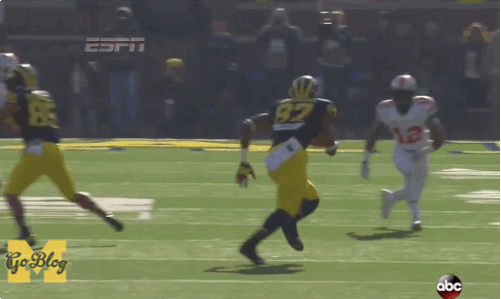
Shooting for the "most times a single GIF hits the front page" record.
Michigan lost one of the most genuinely enjoyable players to watch in recent memory with the graduation of Jeremy Gallon, and unfortunately, I don't think we'll be seeing a 5'8" dude with rocket boots and a cloaking device breaking school receiving records again anytime soon.
That said, the Wolverines don't lack players that can make your jaw drop. Inspired by this Matt Hinton piece on college football's most exciting players, here's my list of the Wolverines who should provide the most entertainment this season. Take note: this isn't a rundown of the best players, but a subjective list of who I think will be the most fun to watch—it's ordered by position, since what constitutes "fun to watch" varies wildly from person to person.
QB Devin Gardner
An obvious choice, especially since some of Gardner's bad habits—namely, reversing field when under pressure—can still produce spectacular results. He's an electric runner even when not at full health. He's got a heck of an arm; this throw against Notre Dame last year simply defies explanation. He continued the grand tradition of Michigan quarterbacks hilariously punking Tanner Miller. His ability to improvise has bailed out the offense on many occasions. Yes, this sometimes gets him into trouble—I know another throw from that otherwise amazing Notre Dame performance is going through your head right now—but it also poses a threat to opponents that is extremely difficult to defend, and it's sure fun to watch when everything clicks.
WR Devin Funchess
Again, an obvious choice is obvious, as evidenced by the GIF that graces the top of this post—and that wasn't the first time Funchess leaped over an oncoming defender:
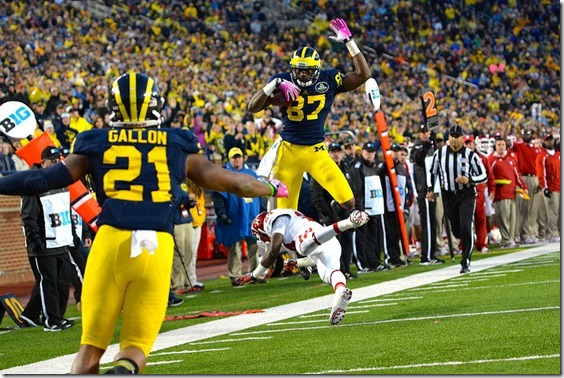
The whole "hurdles defensive backs on the run" thing is pretty great, but that's just a small part of what makes Funchess so remarkable. He's a 6'5", 230-pound former tight end with legitimate top-end speed; his movements bear the grace of a much smaller player. Even when he slips, he seamlessly recovers, and the average defensive back is going to have a very difficult time contending with his ball skills or bringing him down once he makes the catch. Oh, and having oven-mitt-sized hands allows for him to make catches like this while on a dead sprint.
If Funchess isn't on the team in 2015, it'll be because he turned in a monster year and justifiably went pro, and I don't think anybody could begrudge him that move.
[Hit THE JUMP for eight exciting players not named Devin.]
Fuller
This is a companion piece to last week's refresher on inside zone, Michigan's new base play. Outside Zone, also known as the Zone Stretch, is one of two very common complementary plays to IZ, because the technique for the offense isn't very different, but the way the defense has to defend it is (the other complementary play is Power-O, Michigan's extremely nominal base play the last few years).
OZ Resources: Smart Football, Roll Bama Roll, FishDuck (Oregon), BTSC (Steelers) Mile High Report (Denver Broncos), how to Mike.
Outside Zone Defined
The difference, as made obvious by the name, is the point of attack. Inside Zone blocks "downhill"; the running back aims for the first line defender past the center, and picks a lane to either side of the guards. In Outside Zone the back is running to a point outside the five linemen. Some coaches say run to the back of your tight end, others say run to the end man on the line of scrimmage (EMLOS); it comes to the same thing.
Here's Alex Gibbs (from the Elway-era Broncos), via Smart Football:
This is another "base" play. If the defense plays sound against it, the success of the play comes down to execution and talent. As with IZ, if the defense gets too aggressive the reaction to that is built into the play.
This isn't a play that attacks multiple sides; it threatens outside and can come back inside if the defense overreacts to that. Since we're coming into this from a fan perspective I won't get into the footwork you can't see, but you'll recognize Outside Zone immediately because the linemen start out by moving sideways.
As you can see, reps, reps, and more reps turn this into a possibly devastating play. The more you run it, the better the team will react to various things defenders do. In the video above Gibbs talks about the guards "making the read for him [the RB]". The big breaks from OZ come when a guard or center sees a defender reacting too aggressively, let that guy run himself out of the play, and then destroy a back-filling defender.
Recognize Alignment
Like inside zone, the offensive linemen have to read the defensive front to decide before the play begins who they're blocking. The "covered" rules still apply: if someone's lined up over you, you're covered; if not you're uncovered:
The general rule of coveredness still applies: if there's a guy lined up over you, you have to block him. But the whole idea of a zone stretch is it slides the line, so if you're uncovered that means you have to reach the next defender to the playside of you, and if you're covered you're looking to 1) get playside of that dude and 2) combo block him with your uncovered buddy, and 3) release and get downfield.
Combo Blocks
Combo blocking is one of the things that takes lots and lots of reps. The essential blocking rule is don't let anybody cross your visor, and block the guy in your zone. Outside Zone's strength against a base defense is it creates double-teams at the point of attack
How It's Defended
Outside Zone pairs well with Inside Zone because a defense used to IZ can get caught inside, but that should be rare with a well-coached defense because the play is quite obvious from the first step by the offensive linemen, and from what's going on in the backfield (the RB isn't coming downhill). As soon as the defense realizes this they have to get on their horses and prevent the offensive linemen from flanking them, but because of the threat of the cutback, the defense also has to maintain gap responsibility.
There's gonna be a huge temptation for the EMLOS, with the play headed right for him, to square up and end the play right there, but the most important thing (unless they've given him extraordinary safety help) for him is to keep the play inside. The offense knows this, and a good tight end who can get that EMLOS skating wide can create a big hole to run through; a bad tight end will let the EMLOS get leverage and hold him inside, squeezing the hole shut.
Keys to Success
Every little thing the offense does has a potential to make or break this play. The faster the RB makes his cut and accelerates through the decided hole, the bigger this can break.
A fleet-footed, quick-thinking, tough sumbitch of an interior lineman can really make this go. David Molk could consistently get playside of a guy lined up shaded strong on him, and could react so well to defenders that he'd often make the RB's job easy, abandoning a defender running himself out of the play to catch a chasing linebacker and create a gaping hole.
Outside Zone is where a great running back can really shine and a just-a-guy can make the play barely more than a side show. Mike Hart, with his great vision for a developing hole, his super-quick and decisive cut, his great acceleration, and his tiny stature in comparison to the mountain of flesh in front of him, was an awesome Outside Zone running back; if only he had stayed healthy the one year he got to run it consistently.
[One sample play and more coming, after the jump]
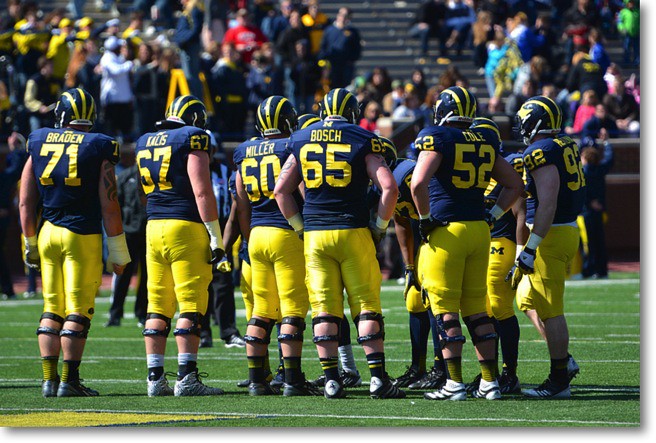
Where to start, really? [Bryan Fuller/MGoBlog]
In Brady Hoke's fourth year at the helm, Michigan heads into fall camp with far fewer questions about the starting lineup than we're used to hearing this time of year; even the offensive line looks pretty much set, though of course concerns about their ability will follow this team well into the season. Today I'm taking a look at the five players—some penciled in as starters, some not—whose emergence is critical to Michigan's success in 2014, either due to the depth at their position, their potential to become a real difference-maker, or both.
You'll be shocked to see that the list begins with an offensive lineman.
RT Ben Braden
Braden is #1 with a bullet for me. He replaces an NFL draft pick at a critical spot on a line in need of a whole lot of improvement, and the options behind him are very limited. Braden has great potential due to his Lewan-wowing combination of size (6'6", 322 lbs.) and athleticism, but there are also significant concerns—that same Lewan article, from last August, stated the starting left guard spot was Braden's to lose, but even in a season when the guards rotated with alarming frequency he played just two games, both as a reserve.
While it's far too early to say a lineman heading into his redshirt sophomore season has panned out or not, the fact that a true freshman and a 6'1" walk-on—Kyle Bosch and Joey Burzynski, respectively—saw the field over Braden last year is certainly worrisome. Adding to that concern is the depth at tackle this season. If Braden can't lock down his spot at right tackle, the first tackle off the bench looks likely to be another true freshman, Mason Cole, if the spring is any indication. A trio of redshirt freshmen provide depth, but none are close to sure things: Logan Tuley-Tillman likely needs at least another year of development, Chris Fox mostly spent last year rehabbing an ACL tear, and David Dawson seems more suited to guard.
It's true that any of Michigan's O-linemen could be on this list—in fact, there's another later—but Braden's spot in the lineup appears the least certain, and he just happens to be in a spot that could cause a complete reshuffling of the line if he can't hold the job.
NT Ondre Pipkins
There are really four interior defensive linemen that could go here; Willie Henry, Chris Wormley, and Maurice Hurst were under serious consideration, but Henry seems like he'll be at least a passable starter, and the three-tech spot—where Wormley and Hurst are slated to play—doesn't have the same importance as the nose (while boasting more depth on this roster). Also, only one of these guys was a five-star All-American out of high school, and it's Pee Wee Pipkins.
Pipkins is, rather shockingly, already a true junior, and his time to make that five-star impact is quickly running out after he blew out an ACL against Minnesota last year, just as he was showing signs of reaching his potential. He's reportedly fully recovered from that injury, though there's no telling how it'll affect him until he's back playing in actual games. If he's healthy, he could develop into some unholy combination of Gabe Watson and Alan Branch; he could also be the next Will Campbell, and that's without accounting for the potential that he's not fully comfortable on that knee.
While Michigan doesn't necessarily need Pipkins in the starting lineup—Henry can start at the nose next to a three-tech platoon of Wormley/Hurst/others—they need him to be healthy and productive enough to rotate in a good deal, unless Bryan Mone is remarkably ahead of the curve for a true freshman nose tackle. It'd also, of course, be really nice to see the affable Pipkins return to the how-the-hell-is-that-blob-chasing-down-Stefon Diggs form he showed in his standout Army AA Game performance a couple years ago.
WR Amara Darboh
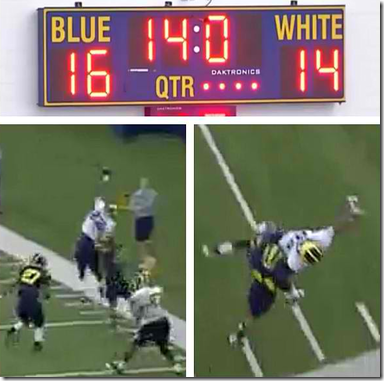 |
| "Today in practice I witnessed the single greatest catch I've ever seen in person." — Devin Gardner |
We got a couple tantalizing looks at Darboh before he missed the 2013 season with a foot injury: the amazing catch from a 2012 Outback Bowl practice (right) and a nice deep sideline grab in the 2013 Spring Game. While Jehu Chesson did a solid job as the #3 receiver last year, Darboh was considered the clear leader for that role—really the #2 receiver role at the time, before everyone figured out Devin Funchess was a tight end in name only—and he also garnered more hype as a recruit.
This admittedly isn't an area of significant need for Michigan; Freddy Canteen, Moe Ways, Jaron Dukes, and DaMario Jones provide plenty of depth and talent at receiver.* None of those guys possess the combination of talent, physical development, and knowledge of the offense that Darboh has right now, however, and the capable-of-catching-anything aspect to Darboh's game is something I'd like to see on the field.
Having a sure-handed possession receiver across from Devin Funchess could make Michigan's passing game downright scary, and early in the season it could also help cover for the absence of a receiving threat at tight end while Jake Butt recovers from his ACL injury. Darboh, who's now listed at 6'2", 211 pounds, potentially fits that bill better than anyone on the roster.
*I'd include Drake Harris, too, but he's coming off a lost senior season of high school due to a hamstring injury and he needs to gain weight, so a redshirt hopefully beckons.
RG Kyle Kalis
This should probably be Jake Butt's spot, but I'm going with Kalis here, since he's a five-star talent on a line in need of that, and after one rough year it appears he's been written off by many. I mean, this was in Brian's post-spring 27 Tickets, when he (ever so jinxfully) assumed now-Buckeye Chad Lindsay would transfer from Alabama to Michigan and take over the center spot:
27. G Kyle Bosch, So. [Last time: 25]
Under assumption that Lindsay comes in, Glasgow displaces one of Braden/Bosch/Kalis. Random guess here is that it's Kalis because Bosch should improve more as younger guy but your guess is as good as mine. So is Hoke's.
Kalis was left out of the top 27.
While I realize Kalis underperformed last year, and not all of that can be chalked up to coaching ... well, you all saw the mess on the line, and assigning individual blame for that tire fire is a difficult, if not impossible, endeavor. Kalis was thrust into a starting job as a redshirt freshman, then moved in and out of the lineup as the coaches tried (and failed) to find something that would work—not exactly a recipe for success for a first-year starter regardless of talent.
And boy, does Kalis have talent. Offensive linemen are the toughest prospects to project with much accuracy, but he looked like the surest of sure things out of high school. Many of his issues last year appeared to stem from uncertainty about his assignment; given his freshmandom and the sheer number of schemes Michigan tried to run last year, that's understandable. The simplified, inside zone-centric offense under Doug Nussmeier should suit him well; if he's confident enough in his knowledge of the playbook to stop thinking and starting clobbering, we could see a huge step forward from him this fall.
NICKEL/S/CB Jabrill Peppers
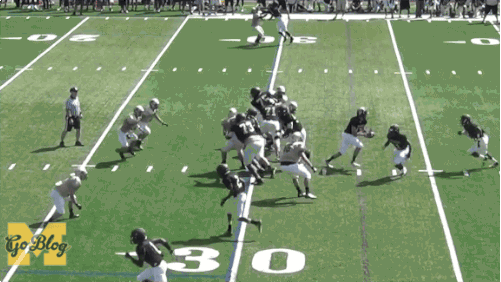
Braden is the #1 X-factor, in my opinion, because of his importance to the team's success this year; if you think of X-factors as players who can make an impact in a number of ways, however, the obvious choice is Peppers. Obviously.
The coaches maintain that they'll start him out at nickel, and he could make a huge difference there as a prototype hybrid space player who's equally adept in coverage and run support. He could very well start from day one at strong safety, the only spot in the secondary with any real uncertainty, and the way Greg Mattison utilized that spot in the Spring Game—aggressively rolling the SS into the box often—is ideally suited for a player like Peppers. He could even challenge Raymon Taylor at boundary corner, though with the rise of Jourdan Lewis the need for Peppers at corner appears less than the two other defensive positions he could play this year.
Personally, I'm hoping that sooner or later he starts at strong safety, where he could bring a level of playmaking Michigan hasn't had back there since... uh... let's go with "a while ago." I don't believe the coaches will ask Peppers to make an impact on offense this year, but special teams is another story—his potential as a return man is massive, and I have a hard time believing the coaches won't try to get the ball in his hands one way or another.
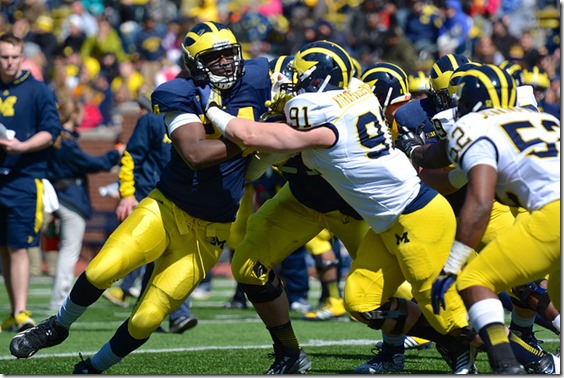
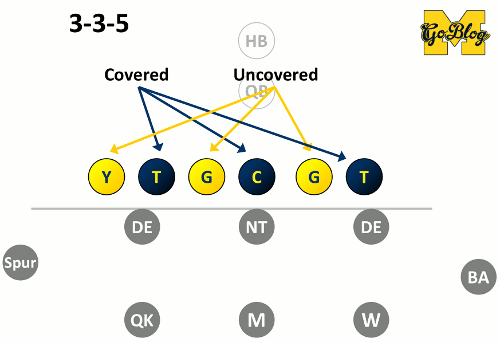

34